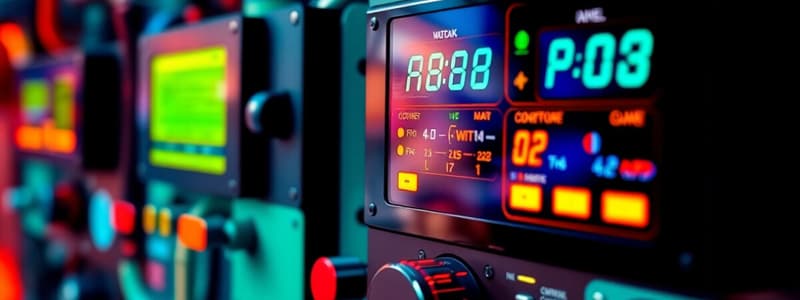Podcast
Questions and Answers
In a proportional controller, what does 'offset' specifically represent?
In a proportional controller, what does 'offset' specifically represent?
- The degree of oscillatory behavior exhibited by the system.
- The duration until the system achieves a steady state.
- The discrepancy between the intended setpoint and the actual steady-state value. (correct)
- The rate at which the system's response changes over time.
Given a P-controller with an initial proportional gain ($K_c = 1$) resulting in an offset of 0.5, what is the effect on the offset when the gain is increased to ($K_c = 5$)?
Given a P-controller with an initial proportional gain ($K_c = 1$) resulting in an offset of 0.5, what is the effect on the offset when the gain is increased to ($K_c = 5$)?
- The system becomes inherently unstable.
- The offset will remain unchanged.
- The offset will decrease. (correct)
- The offset will increase proportionally.
In a P-controller, what is the significance of the proportional gain ($K_c$)?
In a P-controller, what is the significance of the proportional gain ($K_c$)?
- It completely eliminates any steady-state error.
- It influences how closely the system output approaches the setpoint. (correct)
- It is directly proportional to the system's mass.
- It dictates the system's frequency of oscillation.
What is the primary function of the integral action component within a PI controller?
What is the primary function of the integral action component within a PI controller?
For a PI controller subjected to a step-change input, how does increasing the proportional gain ($K_c$) from 1 to 5 typically affect the system's response?
For a PI controller subjected to a step-change input, how does increasing the proportional gain ($K_c$) from 1 to 5 typically affect the system's response?
Why is the process of 'tuning' considered essential for PI controllers?
Why is the process of 'tuning' considered essential for PI controllers?
What unique advantage does the derivative control action offer in PID controllers, beyond what PI controllers provide?
What unique advantage does the derivative control action offer in PID controllers, beyond what PI controllers provide?
For a PID controller configured with $K_c = 5$, $\tau_I = 1.0$, and $\tau_D = 0.25$, what effect does the derivative action introduce to the system's response?
For a PID controller configured with $K_c = 5$, $\tau_I = 1.0$, and $\tau_D = 0.25$, what effect does the derivative action introduce to the system's response?
How does increasing the derivative time constant ($\tau_D$) in a PID controller impact the system's overall performance?
How does increasing the derivative time constant ($\tau_D$) in a PID controller impact the system's overall performance?
What is the fundamental difference between an open-loop and a closed-loop control system?
What is the fundamental difference between an open-loop and a closed-loop control system?
Why is implementing control systems particularly important in higher-order systems?
Why is implementing control systems particularly important in higher-order systems?
What is a defining characteristic of a first-order system's response to a step input?
What is a defining characteristic of a first-order system's response to a step input?
What is the main objective of using a proportional (P) controller in a control system?
What is the main objective of using a proportional (P) controller in a control system?
Which statement accurately describes the primary function of an integral (I) controller?
Which statement accurately describes the primary function of an integral (I) controller?
What primary benefit does a derivative (D) controller provide to a control system?
What primary benefit does a derivative (D) controller provide to a control system?
For a system controlled by a proportional controller with a gain ($K_c$) of 3, what is the resulting offset?
For a system controlled by a proportional controller with a gain ($K_c$) of 3, what is the resulting offset?
In a first-order process managed by a P-controller, what occurs to the offset as the proportional gain ($K_c$) is increased?
In a first-order process managed by a P-controller, what occurs to the offset as the proportional gain ($K_c$) is increased?
In what way does incorporating integral action enhance a proportional controller's performance?
In what way does incorporating integral action enhance a proportional controller's performance?
How does a PI controller perform with a higher proportional gain ($K_c$ = 5)?
How does a PI controller perform with a higher proportional gain ($K_c$ = 5)?
What is the main benefit of using a PID controller over a PI controller?
What is the main benefit of using a PID controller over a PI controller?
Flashcards
What is "offset"?
What is "offset"?
The difference between the desired setpoint and the actual steady-state value in a proportional controller.
P-controller offset and Kc
P-controller offset and Kc
Offset decreases as proportional gain (Kc) increases.
Critical Role of Kc
Critical Role of Kc
It determines how close the system approaches the desired setpoint.
Role of Integral Action
Role of Integral Action
Signup and view all the flashcards
Kc increase: PI Controller
Kc increase: PI Controller
Signup and view all the flashcards
Why tune PI controllers?
Why tune PI controllers?
Signup and view all the flashcards
Derivative control advantage
Derivative control advantage
Signup and view all the flashcards
Increasing tD effect
Increasing tD effect
Signup and view all the flashcards
Closed-loop systems
Closed-loop systems
Signup and view all the flashcards
Control purpose
Control purpose
Signup and view all the flashcards
First-order system
First-order system
Signup and view all the flashcards
Proportional controller purpose
Proportional controller purpose
Signup and view all the flashcards
Integral Controller Role
Integral Controller Role
Signup and view all the flashcards
Derivative controller action
Derivative controller action
Signup and view all the flashcards
Kc impact on offset
Kc impact on offset
Signup and view all the flashcards
Integral Action Improvement
Integral Action Improvement
Signup and view all the flashcards
PID vs. PI Control
PID vs. PI Control
Signup and view all the flashcards
PID controller performance
PID controller performance
Signup and view all the flashcards
Open-loop systems feature
Open-loop systems feature
Signup and view all the flashcards
Fifth-order system in open-loop
Fifth-order system in open-loop
Signup and view all the flashcards
Study Notes
General Concepts
- Offset refers to the difference between the desired setpoint and the actual steady-state value in a proportional controller.
- In a P-controller with ( K_c = 1 ), if ( K_c ) increases to 5, the offset decreases.
- The proportional gain ( K_c ) in a P-controller determines how close the system approaches the setpoint.
PI Controllers
- Integral action in a PI controller eliminates steady-state error.
- In a PI controller, if ( K_c ) increases from 1 to 5 in a step-change input scenario, error correction speeds up significantly.
- Tuning in PI controllers is important to balance the speed of response and stability.
PID Controllers
- Derivative control in a PID controller predicts future error trends to reduce overshoot.
- Derivative action reduces oscillations and overshoot when ( K_c = 5 ), ( \tau_I = 1.0 ), and ( \tau_D = 0.25 ).
- Increasing ( \tau_D ) in a PID controller reduces oscillations and increases stability.
Open-Loop and Closed-Loop Systems
- Closed-loop systems have feedback for self-correction, differentiating them from open-loop systems.
- Control is essential in higher-order systems to handle oscillations and complex responses.
- A key characteristic of a first-order system is its smooth exponential behavior with a defined time constant.
P Controller Purpose
- The primary purpose of a proportional (P) controller is to improve response time while maintaining some offset.
Integral Controller Role
- The role of an integral (I) controller is to eliminate steady-state error.
Derivative Controller Action
- Derivative (D) controller action enhances stability and reduces overshoot.
First Order System Under P Controller
- When the proportional gain ( K_c ) is set to 3, the offset is 0.25.
- As ( K_c ) increases in a P-controller for a first-order process, the offset decreases.
PI Controller Impact
- Adding integral action to a proportional controller provides elimination of offset over time.
- A PI controller with a higher proportional gain (( K_c = 5 )) results in faster error correction with a risk of oscillation.
PID Controller Optimization
- A key advantage of a PID controller compared to PI control is improved response speed and stability.
- With a PID controller where ( K_c = 3 ), ( \tau_I = 1 ), and ( \tau_D = 0.25 ), accuracy and stability improve.
Open Loop and Feedback Systems
- A distinguishing feature of an open-loop control system is its lack of feedback, which results in fixed input-output behavior.
- A fifth-order system in open-loop operation shows a slower and more oscillatory response compared to first-order systems.
Studying That Suits You
Use AI to generate personalized quizzes and flashcards to suit your learning preferences.




